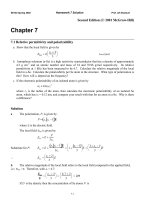Bài tập Vật lý chất rắn (4)
Bạn đang xem bản rút gọn của tài liệu. Xem và tải ngay bản đầy đủ của tài liệu tại đây (242.54 KB, 6 trang )
EE145 Spring 2002 Homework 5 Solution Prof. Ali Shakouri
Second Edition ( 2001 McGraw-Hill)
Chapter 5
5.6 Doped GaAs
Consider the GaAs crystal at 300 K.
a. Calculate the intrinsic conductivity and resistivity.
b. In a sample containing only 10
15
cm
-3
ionized donors, where is the Fermi level? What is the
conductivity of the sample?
c. In a sample containing 10
15
cm
-3
ionized donors and 9 × 10
14
cm
-3
ionized acceptors, what is the
free hole concentration?
Solution
a Given temperature, T = 300 K, and intrinsic GaAs.
From Table 5.1 (in the textbook), n
i
= 1.8 × 10
6
cm
-3
,
µ
e
≈ 8500 cm
2
V
-1
s
-1
and
µ
h
≈ 400 cm
2
V
-1
s
-1
. Thus,
σ
= en
i
(
µ
e
+
µ
h
)
∴
σ
= (1.602 × 10
-19
C)(1.8 × 10
6
cm
-3
)(8500 cm
2
V
-1
s
-1
+ 400 cm
2
V
-1
s
-1
)
∴
σ
= 2.57 × 10
-9
Ω
-1
cm
-1
∴
ρ
= 1/
σ
= 3.89 × 10
8
Ω cm
b Donors are now introduced. At room temperature, n = N
d
= 10
15
cm
-3
>> n
i
>> p.
σ
n
= eN
d
µ
e
≈ (1.602 × 10
-19
C)(10
15
cm
-3
)(8500 cm
2
V
-1
s
-1
) = 1.36 Ω
-1
cm
-1
∴
ρ
n
= 1/
σ
n
= 0.735 Ω cm
In the intrinsic sample, E
F
= E
Fi
,
n
i
= N
c
exp[−(E
c
− E
Fi
)/kT] (1)
In the doped sample, n = N
d
, E
F
= E
Fn
,
n = N
d
= N
c
exp[−(E
c
− E
Fn
)/kT] (2)
Eqn. (2) divided by Eqn. (1) gives,
N
d
n
i
= exp
E
Fn
−
E
Fi
kT
(3)
∴ ∆E
F
= E
Fn
− E
Fi
= kT ln(N
d
/n
i
)
(4)
Substituting we find,
∆E
F
= (8.617 × 10
-5
eV/K)(300 K)ln[(10
15
cm
-3
)/(1.8 × 10
6
cm
-3
)]
∴ ∆E
F
= 0.521 eV above E
Fi
(intrinsic Fermi level)
5.1
EE145 Spring 2002 Homework 5 Solution Prof. Ali Shakouri
c The sample is further doped with N
a
= 9 × 10
14
cm
-3
= 0.9 × 10
15
cm
-3
acceptors. Due to
compensation, the net effect is still an n-type semiconductor
but with an electron concentration given
by,
n = N
d
− N
a
= 10
15
cm
-3
− 0.9 × 10
15
cm
-3
= 1 × 10
14
cm
-3
(>> n
i
)
The sample is still n-type though there are less electrons than before due to the compensation
effect. From the mass action law, the hole concentration is:
p = n
i
2
/ n = (1.8 × 10
6
cm
-3
)
2
/ (1 × 10
14
cm
-3
) = 0.0324 cm
-3
On average there are virtually no holes in 1 cm
3
of sample.
We can also calculate the new conductivity. We note that electron scattering now occurs from
N
a
+ N
d
number of ionized centers though we will assume that
µ
e
≈ 8500 cm
2
V
-1
s
-1
.
σ
= en
µ
e
≈ (1.602 × 10
-19
C)(10
14
cm
-3
)(8500 cm
2
V
-1
s
-1
) = 0.136 Ω
-1
cm
-1
5.7 Degenerate semiconductor
Consider the general exponential expression for the concentration of electrons in the CB,
n = N
c
exp −
(
E
c
−
E
F
)
kT
and the mass action law, np = n
i
2
. What happens when the doping level is such that n approaches N
c
and exceeds it? Can you still use the above expressions for n and p?
Consider an n-type Si that has been heavily doped and the electron concentration in the CB is
10
20
cm
-3
. Where is the Fermi level? Can you use np = n
i
2
to find the hole concentration? What is its
resistivity? How does this compare with a typical metal? What use is such a semiconductor?
Solution
Consider n
= N
c
exp[−(E
c
− E
F
)/kT] (1)
and np = n
i
2
(2)
These expressions have been derived using the Boltzmann tail (E > E
F
+ a few kT) to the
Fermi − Dirac (FD) function f(E) as in Section 5.1.4 (in the textbook). Therefore the expressions are
NOT valid when the Fermi level is within a few kT of E
c
. In these cases, we need to consider the
behavior of the FD function f(E) rather than its tail and the expressions for n and p are complicated.
It is helpful to put the 10
20
cm
-3
doping level into perspective by considering the number of
atoms per unit volume (atomic concentration, n
Si
) in the Si crystal:
n
at
=
(Density)N
A
M
at
=
(2.33
×
10
3
kg m
-3
)(6.022
×
10
23
mol
−
1
)
−3 −1
(28.09 ×10
kg mol )
i.e. n
at
= 4.995 × 10
28
m
-3
or 4.995 × 10
22
cm
-3
Given that the electron concentration n = 10
20
cm
-3
(not necessarily the donor concentration!),
we see that
5.2
EE145 Spring 2002 Homework 5 Solution Prof. Ali Shakouri
n/n
at
= (10
20
cm
-3
) / (4.995 × 10
22
cm
-3
) = 0.00200
which means that if all donors could be ionized we would need 1 in 500 doping or 0.2% donor doping
in the semiconductor (n is not exactly N
d
for degenerate semiconductors). We cannot use Equation (1)
to find the position of E
F
. The Fermi level will be in the conduction band. The semiconductor is
degenerate (see Figure 5Q7-1).
(a)
(b)
E
Fp
E
v
E
c
E
Fn
E
v
E
c
CB
VB
CB
E
g(E)
Impurities
forming a band
Figure 5Q7-1
(a) Degenerate n-type semiconductor. Large number of donors form a band
that overlaps the CB.
(b) Degenerate p-type semiconductor.
50
100
1000
2000
10
15
10
16
10
17
10
18
10
19
10
20
Electrons
Holes
Dopant Concentration, cm
-3
Figure 5Q7-2 The variation of the drift mobility with dopant concentration
in Si for electrons and holes at 300 K.
Take T = 300 K, and
µ
e
≈ 900 cm
2
V
-1
s
-1
from Figure 5Q7-2. The resistivity is
ρ
= 1/(en
µ
e
) = 1/[(1.602 × 10
-19
C)(10
20
cm
-3
)(900 cm
2
V
-1
s
-1
)]
∴
ρ
= 6.94 × 10
-5
Ω cm or 694 × 10
-7
Ω m
Compare this with a metal alloy such as nichrome which has
ρ
= 1000 nΩ m = 10 × 10
-7
Ω m.
The difference is only about a factor of 70.
5.3
EE145 Spring 2002 Homework 5 Solution Prof. Ali Shakouri
This degenerate semiconductor behaves almost like a “metal”. Heavily doped degenerate
semiconductors are used in various MOS (metal- oxide- semiconductor) devices where they serve as the
gate electrode (substituting for a metal) or interconnect lines.
5.8 Photoconductivity and speed
Solution
t
A
B
t = 0
Time
t ′
Time
G
ph
Laser on
t = 0
Laser off
t = 10
µ
s
τ
A
τ
B
τ
A
τ
B
τ
A
G
ph
τ
B
G
ph
t ′ = 0
Consider two
p
-type Si samples both doped with 10
15
B atoms cm
-3
. Both have
identical dimensions of length
L
(1 mm), width
W
(1 mm), and depth (thickness)
D
(0.1
mm). One sample, labeled
A
, has an electron lifetime of 1
µ
s whereas the other, labeled
B
, has an electron lifetime of 5
µ
s.
a
. At time
t
= 0, a laser light of wavelength 750 nm is switched on to illuminate the
surface (
L
×
W
) of both the samples. The incident laser light intensity on bot
h
samples is 10 mW cm
-2
. At time
t
= 50
µ
s, the laser is switched off. Sketch the time
evolution of the minority carrier concentration for both samples on the same axes.
b
. What is the photocurrent (current due to illumination alone) if each sample is
connected to a 1 V battery?
a
Figure 5Q8-1 Schematic sketch of the excess carrier concentration in the samples A and B as a
function of time from the laser switch-on to beyond laser switch-off.
5.4
EE145 Spring 2002 Homework 5 Solution Prof. Ali Shakouri
b From the mobility vs. dopant graph (Figure 5Q8-2),
µ
h
= 450 × 10
-4
m
2
V
-1
s
-1
and
µ
e
= 1300 ×
10
-4
m
2
V
-1
s
-1
. Given are the wavelength of illumination
λ
= 750 × 10
-9
m, light intensity I = 100
W/m
2
, length L = 1 mm, width W = 1 mm, and depth (thickness) D = 0.1 mm.
50
100
1000
2000
10
15
10
16
10
17
10
18
10
19
10
20
Dopant Concentration, cm
-3
Electrons
Holes
Figure 5Q8-2 The variation of the drift mobility with dopant concentration
in Si for electrons and holes at 300 K.
The photoconductivity is given by (see Example 5.11 in the textbook):
∆
σ
=
e
η
I
λ
τ
µ
e
+
µ
h
()
hcD
where
η
= 1 is the quantum efficiency. Assume all light intensity is absorbed (correct assumption as the
absorption coefficient at this wavelength is large). The photocurrent density and hence the photo
current is given by:
∆J = ∆I/A = E∆
σ
Substitute: ∆I = W × D()
V
L
e
η
I
λ
τ
µ
e
+
µ
h
()
hcD
∴
∆I =
WVe
η
I
λ
τ
µ
e
+
µ
h
()
Lhc
The photocurrent will travel perpendicular to the
W × D direction, while the electric field E will
be directed along
L. Substituting the given values for sample A (electron lifetime
τ
A
= 10
-6
s, voltage V
= 1 V):
∆I
A
=
0.001 m
()1 V()1.602 × 10
−19
C
()
1()100 W/m
2
()
750 ×10
−9
m
()
10
−6
s
()
0.13
m
2
V s
+ 0.045
m
2
V s
0.001 m
()6.626 ×10
−34
J s
()
3.0 ×10
8
m/s
()
∴ ∆I
A
= 1.06 × 10
-5
A
The photocurrent in sample B can be calculated with the same equation, using the given value of
τ
B
= 5 × 10
-6
s. After calculation:
∆I
B
= 5.29 × 10
-5
A
5.5
EE145 Spring 2002 Homework 5 Solution Prof. Ali Shakouri
5.6









